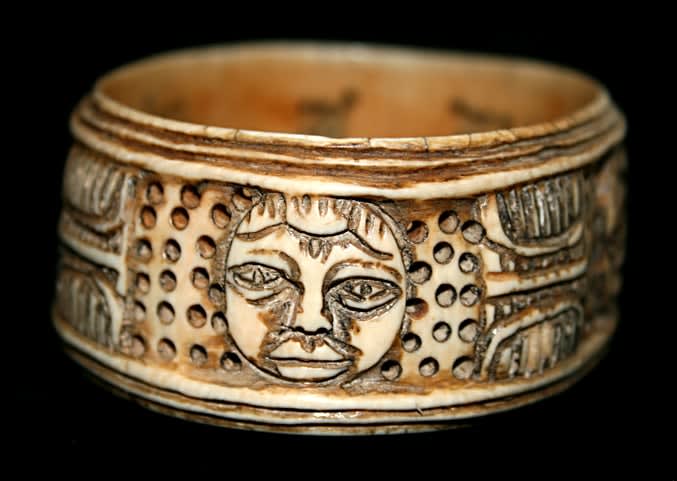Benin Style Ivory Braclet with Face Masks, 20th Century CE
Ivory
3.5 x 1.5
GC.112 (LSO)
This striking ivory bangle was made for a high-ranking member of a Benin Royal court. The piece is cut from a section of elephant’s tusk, and it decorated with alternating...
This striking ivory bangle was made for a high-ranking member of a Benin Royal court. The piece is cut from a section of elephant’s tusk, and it decorated with alternating faces and linear/dot motifs. The ornate nature of the headwear and the double-scarring on the forehead suggests that the faces represent the Oba – the divinely-appointed and hereditary leader of the Benin polity. The Oba was very powerful, and also received half the ivory harvested in his kingdom, and the first refusal on the other half. Ivory pieces such as this were expensive and luxury items.
The kingdom of Benin can justifiably lay claim to having produced the finest artists and craftsmen in the history of the African continent. Yet this heritage was scarcely recognised until the British punitive expedition of 1897, which destroyed and looted the ancient city compounds and in so doing brought the achievements of Benin to the world’s attention (Bacquart 1998). The foundation of the Benin peoples was contemporary with the European late mediaeval period, when the kingdom of Benin was founded by a descendent of an Ife king in c.1180 AD. In the 15th and 16th centuries AD the power of the empire stretched across most of West Africa, and those areas not under their control were indirectly influenced by the effect of their trade networks and material culture styles. Until the late 19th century, the Benin centres were a ruling power in Nigeria, dominating trade routes and amassing enormous wealth as the military and economic leaders of their ancient empire. The power of this empire was unequalled in its time, and the full extent of the rulers’ wealth only became apparent in the aftermath of its destruction.
Benin art is primarily based around a court context, and was designed to venerate the achievements and/or memory of the Obas, the divine rulers of the Benin polities. The artists and craftsmen were typically attached to a specific court, and charged with manufacture of objects solely for their ruler. Their work in bronze and copper, ironworking and sculpting in a range of materials that particularly included ivory was extremely refined and effective; indeed, smelting, forging and cire perdue (lost wax) metalworking methods exceeded any seen in Europe until the 19th century.
This piece may have been worn by a member of the royal family or other high-ranking members of the royal court. Being made from ivory, it would have been an elite, expensive item which was worn in the full pomp and splendour of the Benin court. This is a beautifully made and even wearable piece of African art, and a deserving addition to any serious collection.
Ezra, K. 1992. Royal Art of Benin: the Perls Collection. Metropolitan Museum of Art, NYC.
The kingdom of Benin can justifiably lay claim to having produced the finest artists and craftsmen in the history of the African continent. Yet this heritage was scarcely recognised until the British punitive expedition of 1897, which destroyed and looted the ancient city compounds and in so doing brought the achievements of Benin to the world’s attention (Bacquart 1998). The foundation of the Benin peoples was contemporary with the European late mediaeval period, when the kingdom of Benin was founded by a descendent of an Ife king in c.1180 AD. In the 15th and 16th centuries AD the power of the empire stretched across most of West Africa, and those areas not under their control were indirectly influenced by the effect of their trade networks and material culture styles. Until the late 19th century, the Benin centres were a ruling power in Nigeria, dominating trade routes and amassing enormous wealth as the military and economic leaders of their ancient empire. The power of this empire was unequalled in its time, and the full extent of the rulers’ wealth only became apparent in the aftermath of its destruction.
Benin art is primarily based around a court context, and was designed to venerate the achievements and/or memory of the Obas, the divine rulers of the Benin polities. The artists and craftsmen were typically attached to a specific court, and charged with manufacture of objects solely for their ruler. Their work in bronze and copper, ironworking and sculpting in a range of materials that particularly included ivory was extremely refined and effective; indeed, smelting, forging and cire perdue (lost wax) metalworking methods exceeded any seen in Europe until the 19th century.
This piece may have been worn by a member of the royal family or other high-ranking members of the royal court. Being made from ivory, it would have been an elite, expensive item which was worn in the full pomp and splendour of the Benin court. This is a beautifully made and even wearable piece of African art, and a deserving addition to any serious collection.
Ezra, K. 1992. Royal Art of Benin: the Perls Collection. Metropolitan Museum of Art, NYC.
